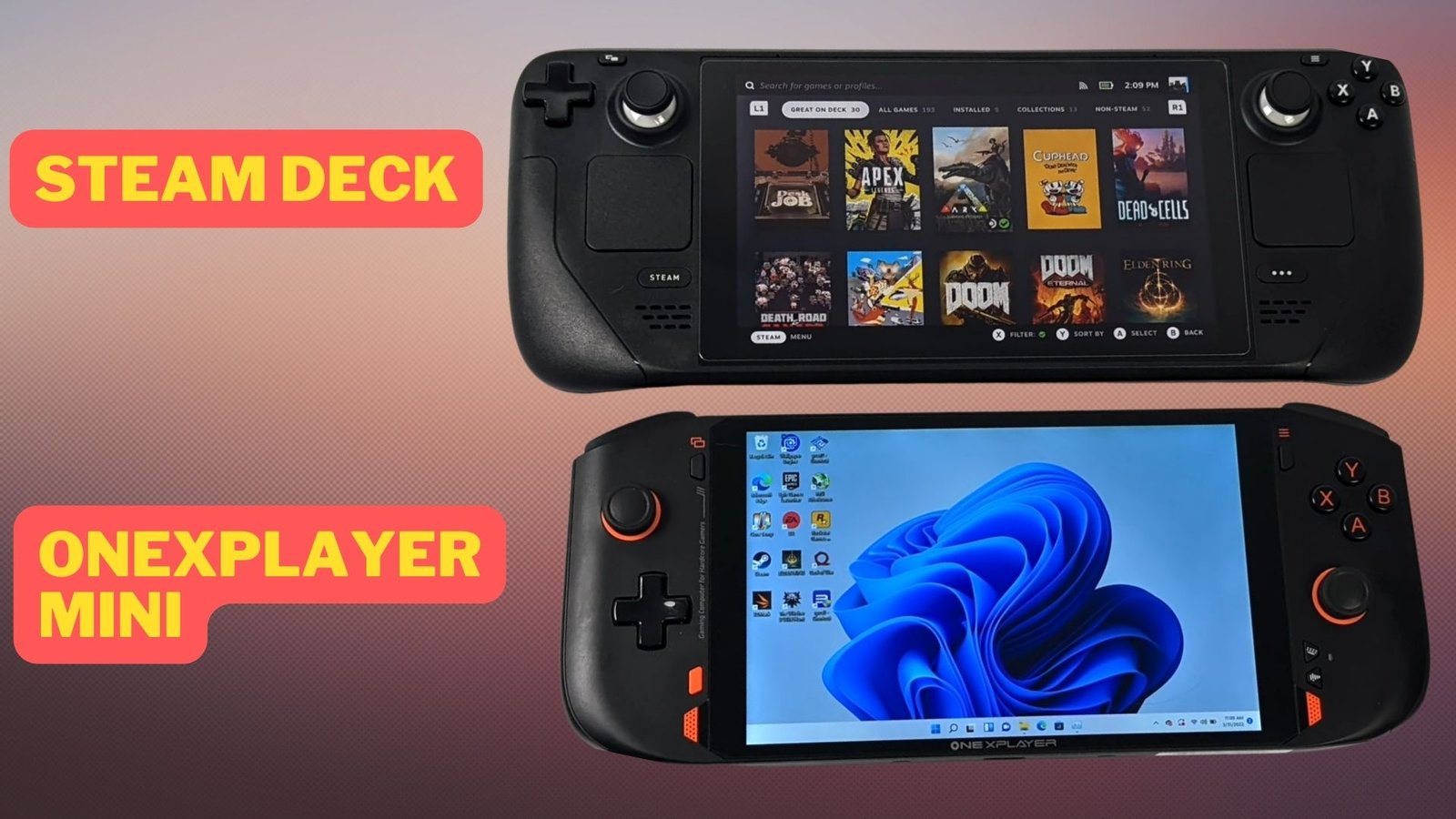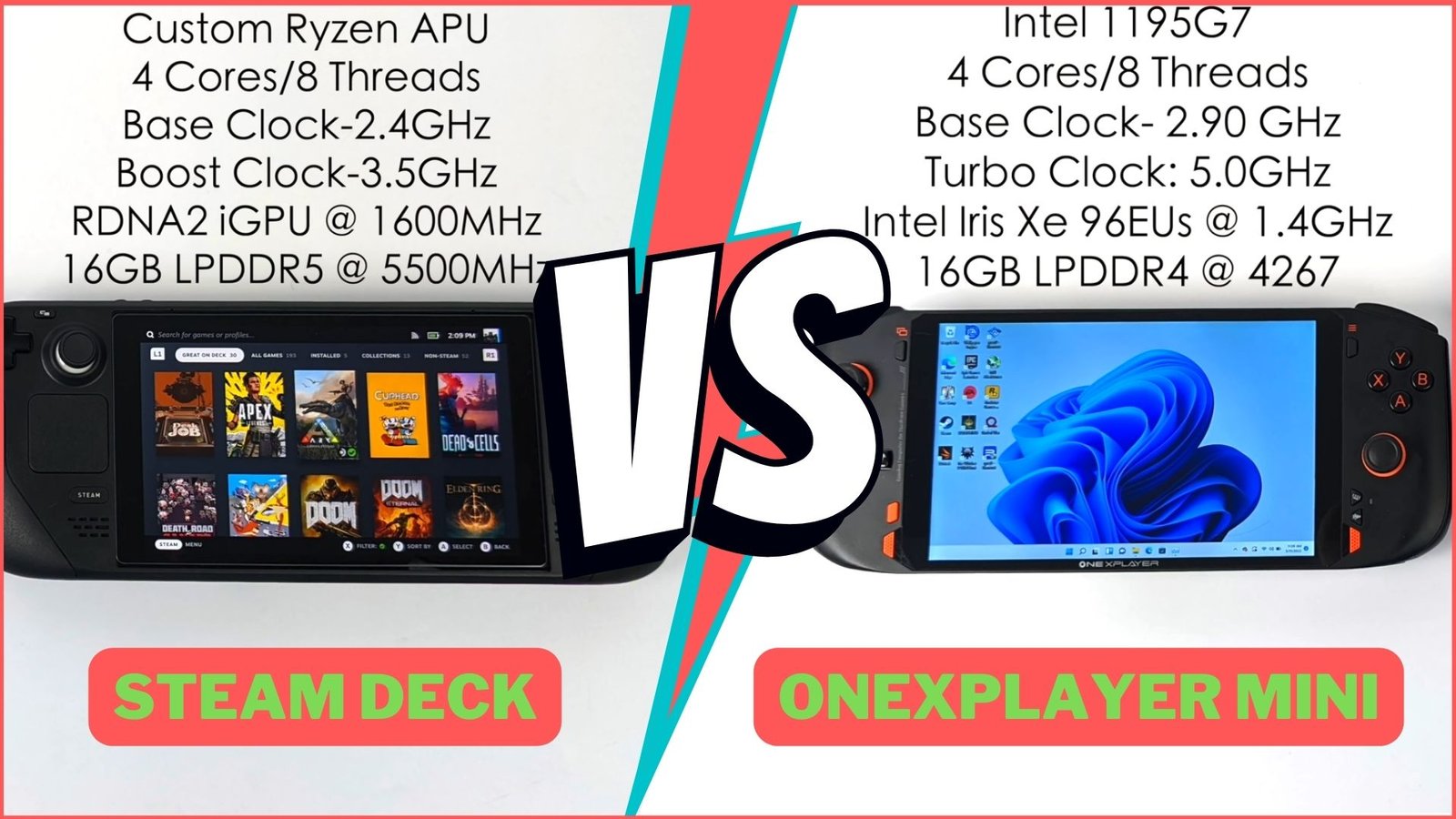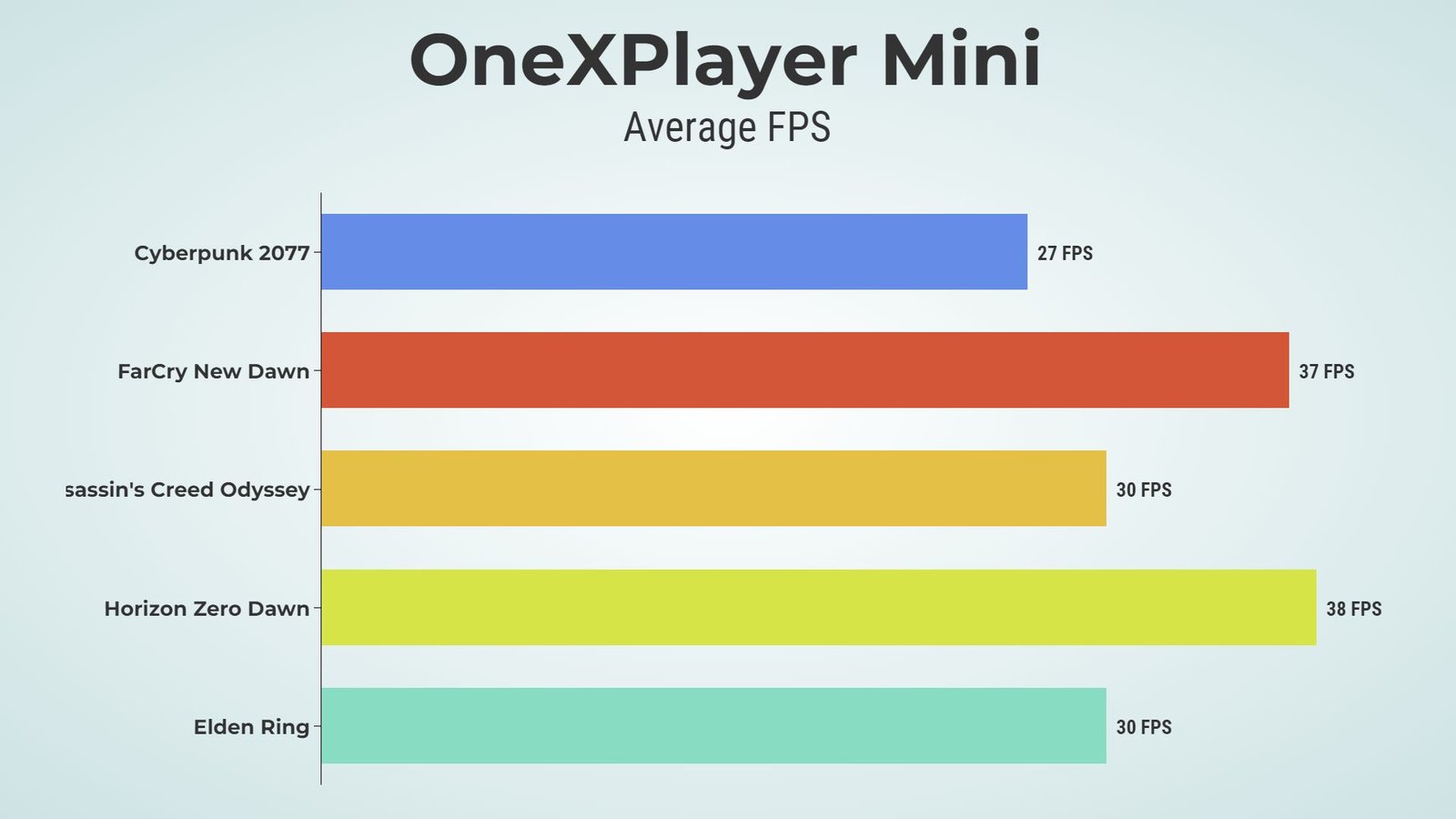Steam Deck vs OneXPlayer Mini: Handheld PC Console Comparision
The handheld Steam Deck shines the brightest as a low-cost PC gaming option, adding more value than its price tag. On the other hand, there are plenty of modern gaming controllers with significantly better specifications than the Steam Deck, and the OneXPlayer Mini is one of them, with really beefy internal hardware, so which one would you prefer? Look into this comparison.
Pros & Cons
| Steam Deck | OneXPlayer Mini |
| Large 7-inch screen | Large 7-inch screen |
| Well-equipped for its size | Excellent build quality |
| RDNA2 graphics chipset | Familiar Windows OS |
| Limited compatible games | Upto 2 TB of SSD storage |
| Limited storage space | Power cord is short in length |
Steam Deck Features
Price Advantage: The Steam Deck is significantly cheaper compared to the OneXPlayer Mini, making it a more affordable option for many consumers.
Convenience and Integration: The Steam Deck offers a seamless gaming experience with its touch pads, paddles, and integrated gyro, providing better control and overall convenience.
Gaming Performance: The Steam Deck’s custom AMD chip performs better in traditional gaming, providing smoother and more reliable gameplay in demanding titles.
Availability: While the Steam Deck had initial availability issues, it is still a more widely anticipated device with ongoing production and distribution plans.
OneXPlayer Mini Features
Emulation Performance: The OneXPlayer Mini outperforms the Steam Deck in CPU-intensive tasks, making it a better option for emulation and certain non-gaming applications.
Better Windows Compatibility: The OneXPlayer Mini’s X-input controls make it more compatible with non-Steam games on Windows, offering broader game compatibility.
Available Now: Unlike the Steam Deck, which faced availability delays, the OneXPlayer Mini is readily available for purchase, making it a suitable choice for those who don’t want to wait.
Form Factor and Controls: The OneXPlayer Mini’s form factor and controls, such as the D-pad and clicky buttons, offer a comfortable and satisfying gaming experience.
Specification
| Steam Deck | OneXPlayer Mini | |
| Released | Feb 25, 2022 | Jan 17, 2022 |
| Weight | 669g | 589g |
| OS | Arch Linux, SteamOS 3.0 | Windows 11 |
| CPU | AMD Zen 2, 4 core, 8-thread | AMD Zen 3, 8 core, 16-thread |
| GPU | AMD RDNA 2, 8 Compute Units, 1.6GHz | AMD Vega 8, 2.0 GHz |
| SoC | AMD Van Gogh | Ryzen 7 5800U |
| Memory | 16GB LPDDR5-5500 | 16GB LPDDR4X-4266 |
| Storage | Up to 512GB NVMe (stock) | Up to 2TB NVMe |
| Display Size | 7-inch IPS panel | 7-inch IPS panel |
| Display Resolution | 1200 x 800 | Up to 1920 x 1200 |
| Connectivity | WiFi 5, Bluetooth 5 | WiFi 6, Bluetooth 5.0, 2x USB 4.0 |
Design: Steam Deck vs OneXPlayer Mini
Before we compare both of these incredible handhelds, we must first examine their designs. Let’s start with the OneXPlayer mini, which is smaller than the steam deck, and if you’re familiar with the original OneXPlayer, then this design will be familiar to you, because the OneXPlayer mini is almost identical to the original OneXPlayer, except for sculpted handles on the back for your hands, which definitely ensures your comfort, no matter how long you’re playing games for, and other than that, both OneXPlayer Miniogue sticks, d-pads, and triggers are Despite being larger, the Steam deck is still much larger than the 1X player mini.

Comfort: Steam Deck vs OneXPlayer Mini
This handheld feels great. The small OneXPlayer lacks the back’s four remap buttons. Additionally, the analogue sticks, d-pad, and triggers are naturally accessible. The dual trackpads are also noteworthy. These track pads are important for additional movements in RTS and mobile games; therefore, design-wise, both sides should be different as they share an aesthetic and branding.
The back trackpad and remap buttons give Steam’s Deck the edge in user friendliness. Even with these extra features, the portable One X, Player, Tiny, and Steam Deck consoles look great.
Display: Steam Deck vs OneXPlayer Mini
Moving on to the display, there isn’t much of a difference between these two consoles, as they both have a 7-inch touchscreen display and a resolution of 1280 x 800, but there is one small difference, and that is the pixel density. In this case, the OneXPlayer Mini has 216 pixels per inch, while the Steam Deck has 215 pixels per inch, which is barely noticeable.
In short, if you’re familiar with modern handheld consoles, you’ll love the display on both of these devices because they both fit in perfectly with a modern handheld console.
Performance: Steam Deck vs OneXPlayer Mini
Steam Deck has a Zen 2 Rising APU with four cores and eight threads, with maximum booster frequencies of up to three gigahertz.
Unlike the OneXPlayer Mini, the Steam deck uses the RDNA2 Graphics chipset, which has a maximum clock speed of 1.6 gigahertz and is powerful enough to handle most modern PC games.
The steam deck has a slightly lower processor than the One X player mini, but thanks to the additional RDNA2 chipset support, the graphical performance is truly exceptional, and the deck, like the One X player mini steam, is equipped with 16 GB of LPDDR5 RAM. The maximum storage capacity here is only 512 GB of SSD, but you can always add an additional microSD card extending up to 1 TB. The 5313 mAh battery life can deliver a maximum of 2 to 8 hours of playtime, depending on the type of game you’re playing.

Looking at the OneXPlayer Mini’s internal specifications, it’s clear that it’s capable of running most modern AAA titles without issue. It is different from other handheld gaming devices because it has a 12th-generation Intel Core i7 processor with 12 cores and 16 threads. It also has 16 GB of LPDDR5 RAM with a maximum boost frequency of up to 5200 MHz and up to 2 terabytes of SSD storage to support high storage, demanding games.
It has an integrated Intel Iris XC graphics processor and a 12450 milliamp-hour battery that can last up to 5 hours, depending on the game. So, if you’re looking to experience modern AAA games in the palm of your hand, this console will not disappoint.
When we compare the internal specifications of these two consoles? We can see that OneXPlayer Mini has the advantage in terms of internal hardware, as it has a powerful processor and PCI Express 4.0 support. Even those team index processors, however, are less powerful. On this handheld, the RDNA2 chipset delivers truly magical performance.


Price
As we come to a conclusion, it looks like the price tag also plays a big role in how affordable something is and what options buyers have. The starting price for the OneXPlayer Mini with 16 GB RAM and one terabyte of SSD is 939.99 USD, and the two terabyte version is 1000 USD.
Meanwhile, the Steam Deck with 64 GB of emmc storage costs only $399 USD, while the maxed-out version with 512 GB of SSD costs $649 USD.
So, yes, when it comes to affordability, the Steam Deck clearly wins the race, as it is completely unbeatable in terms of price and performance, but when everything else is considered, the OneXPlayer Mini is packed with pretty beefy internal hardware. On the plus side, their prices are reasonable.
Key Differences
The key differences between the Steam Deck and the OneXPlayer Mini are:
Price: The Steam Deck is significantly cheaper than the OneXPlayer Mini. The price difference is substantial, making the Steam Deck a more budget-friendly option for gamers.
Availability: The Steam Deck faced availability issues during its launch, with delays in fulfilling pre-orders. On the other hand, the OneXPlayer Mini is readily available for purchase, making it a more accessible choice for those who want a handheld PC gaming console immediately.
Performance: The Steam Deck’s custom AMD chip performs better in traditional gaming, providing smoother and more reliable gameplay in demanding titles. On the other hand, the OneXPlayer Mini’s Intel i7 chip excels in CPU-intensive tasks, making it a better option for emulation and certain non-gaming applications.
Controls and Form Factor: Both devices offer comfortable handheld gaming experiences, but there are differences in controls and form factor. The Steam Deck features touch pads, paddles, and integrated gyro for more convenience, while the OneXPlayer Mini has clicky buttons and a D-pad, providing a more tactile feel during gameplay.
Windows Compatibility: The OneXPlayer Mini’s X-input controls offer better compatibility with non-Steam games on Windows, making it more versatile for playing a wide range of games from various platforms. In contrast, the Steam Deck may require third-party software for optimal game compatibility outside of Steam.
Cooling and Heat: The OneXPlayer Mini’s Intel chip draws more power and outputs more heat during intensive gaming, resulting in a louder fan and potential thermal limitations compared to the Steam Deck’s custom AMD chip, which is designed for better thermal efficiency.
Conclusion!
The Steam Deck is a more affordable and widely anticipated handheld gaming console with better overall gaming performance and more convenient features, while the OneXPlayer Mini excels in CPU-intensive tasks, offers better Windows compatibility, and is readily available for purchase. The choice between the two devices depends on individual priorities, such as budget, gaming preferences, and the urgency to get a handheld PC gaming console.


